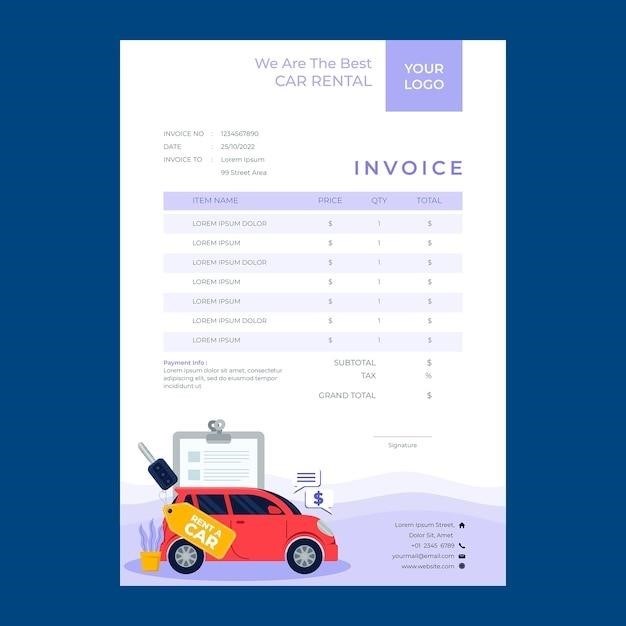
CDL Pre-Trip Inspection Checklist PDF⁚ A Comprehensive Guide
This comprehensive guide provides a detailed CDL pre-trip inspection checklist PDF, outlining the key components of a thorough safety inspection for commercial vehicles. Learn the importance of pre-trip inspections, understand the key components of the checklist, and discover additional resources for passing the CDL pre-trip inspection exam.
Introduction
The CDL pre-trip inspection is a crucial step in ensuring the safety of commercial vehicles and the drivers operating them. This comprehensive inspection process is designed to identify any potential hazards or malfunctions that could compromise the vehicle’s roadworthiness and potentially lead to accidents. Performing a thorough pre-trip inspection not only protects the driver and passengers but also minimizes the risk of costly repairs and delays. This guide provides a detailed CDL pre-trip inspection checklist PDF, covering all essential components of a comprehensive inspection. It serves as a valuable resource for both new drivers preparing for their CDL exam and experienced drivers aiming to maintain a high standard of safety on the road.
Importance of Pre-Trip Inspections
Pre-trip inspections are not merely a formality; they are a vital safety measure for commercial vehicle operators. A thorough inspection helps to identify and address potential hazards that could lead to accidents, breakdowns, and costly repairs. By detecting issues like tire wear, brake problems, fluid leaks, and faulty lights before hitting the road, drivers can take corrective action, ensuring the safety of themselves, passengers, and other road users. Furthermore, pre-trip inspections play a crucial role in complying with DOT regulations. Failing to conduct a proper pre-trip inspection can result in fines and penalties, potentially affecting a driver’s license and employment. Ultimately, the importance of pre-trip inspections lies in their contribution to a safer and more efficient transportation system.
CDL Pre-Trip Inspection Checklist⁚ Key Components
A comprehensive CDL pre-trip inspection checklist covers a wide range of vehicle components, ensuring a thorough safety assessment. The checklist typically includes sections for the front of the vehicle, engine compartment, engine start and cab check, steering, suspension, brakes, wheels, and the side of the vehicle. Each section outlines specific items to inspect, such as lights, reflectors, tires, fluids, gauges, and more. For example, when checking the front of the vehicle, a driver should assess the condition of the headlights, turn signals, brake lights, and license plate. In the engine compartment, the driver should inspect the belts, hoses, fluids, and engine components for signs of wear or damage. This systematic approach ensures that all critical areas of the vehicle are carefully examined, maximizing safety and preventing potential problems on the road.
Front of the Vehicle
The front of the vehicle inspection is a crucial part of the CDL pre-trip checklist, focusing on the driver’s ability to see and be seen. Key components include⁚
- Headlights⁚ Ensure headlights are clean, not cracked or broken, and function correctly. Check both high and low beams.
- Turn Signals⁚ Verify that turn signals are clean, functioning properly, and illuminate with the appropriate color.
- Brake Lights⁚ Inspect brake lights to ensure they are clean, not damaged, and illuminate brightly when the brakes are applied.
- License Plate⁚ Check that the license plate is securely attached, clean, and displays current registration information.
- Bumper⁚ Inspect the bumper for any cracks, bends, or damage. Ensure it is securely attached to the vehicle.
- Grill⁚ Examine the grill for any cracks or damage. Check for leaks in the grill area.
- Clearance Lights⁚ Verify clearance lights are clean, functioning properly, and illuminate with the appropriate color.
This thorough inspection of the front of the vehicle ensures that all essential lights and components are in good working order, enhancing visibility and road safety.
Engine Compartment
The engine compartment inspection is a vital part of the CDL pre-trip checklist, ensuring the vehicle’s engine and related systems are functioning properly. This section requires a thorough inspection of various components⁚
- Engine Oil Level⁚ Check the engine oil level using the dipstick. Ensure the oil is clean and at the appropriate level.
- Coolant Level⁚ Inspect the coolant reservoir to verify the coolant level is sufficient and that the coolant is clean. Look for any leaks or signs of overheating.
- Power Steering Fluid⁚ Check the power steering fluid level and ensure it is clean and at the proper level. Examine the power steering system for any leaks.
- Brake Fluid Level⁚ Inspect the brake fluid reservoir and ensure the fluid is at the proper level. Look for any signs of contamination or leaks.
- Air Compressor⁚ Check the air compressor for any leaks or signs of damage. Ensure the air pressure is within the acceptable range.
- Air Lines⁚ Inspect all air lines for leaks, damage, and proper connections. Ensure all lines are securely fastened.
- Belts⁚ Examine all belts for wear, cracks, or damage. Ensure the belts are properly tensioned.
- Hoses⁚ Inspect hoses for leaks, cracks, or damage. Ensure all hoses are securely clamped.
This comprehensive check of the engine compartment ensures the vehicle’s essential systems are in optimal working order, contributing to overall safety and performance.
Engine Start and Cab Check
The engine start and cab check is a crucial part of the CDL pre-trip inspection checklist, ensuring the vehicle’s operational readiness and driver safety. This section involves the following procedures⁚
- Engine Start⁚ Start the engine and listen for any unusual noises, such as knocking, rattling, or grinding. Check the engine oil pressure gauge to ensure it reaches the appropriate level. Look for any smoke coming from the exhaust.
- Gauges and Warning Lights⁚ Monitor all gauges and warning lights on the instrument panel. Ensure all gauges are functioning correctly and that there are no warning lights illuminated. Check the air pressure gauge for a consistent reading.
- Air Brakes⁚ Activate the air brakes and listen for any abnormal noises or leaks. Check the air brake system for proper operation, ensuring the air pressure builds up to the required level.
- Steering Wheel⁚ Turn the steering wheel from lock to lock, checking for any binding or unusual noises. Ensure the steering wheel is properly centered and responsive.
- Mirrors and Windshield⁚ Inspect all mirrors for cracks, damage, or obstructions. Ensure the windshield is clean and free from any cracks or damage. Adjust the mirrors for optimal visibility.
- Wipers and Washers⁚ Test the windshield wipers and washer system. Ensure they operate properly and that the windshield washer fluid reservoir is full.
- Horn⁚ Test the horn to ensure it is functioning properly.
- Lights and Signals⁚ Activate all lights and signals, including headlights, taillights, brake lights, turn signals, and hazard lights. Check that all lights are working properly and that the bulbs are not burnt out.
By performing these checks, you can ensure a safe and efficient start to your journey.
Steering
The steering system is a critical component for safe vehicle operation. During the CDL pre-trip inspection, it is essential to thoroughly check the steering components for any defects or issues that could compromise safety. Here is a breakdown of the essential steps to inspect⁚
- Steering Wheel⁚ Inspect the steering wheel for cracks, damage, or excessive wear. Ensure it is securely mounted and spins freely without any binding or unusual noises. Check that the steering wheel is centered and responsive when turned from lock to lock.
- Steering Column⁚ Examine the steering column for any damage, leaks, or signs of excessive wear. Ensure the column is securely attached and that there are no loose components or cracks. Check for any signs of corrosion or rust.
- Steering Gear⁚ Inspect the steering gear, including the steering box and power steering unit, for any leaks, damage, or excessive wear. Check for any signs of looseness or play in the steering gear. Listen for any unusual noises or grinding sounds during operation.
- Tie Rod Ends⁚ Check the tie rod ends for any signs of wear, damage, or excessive play. Ensure they are securely attached and that there are no loose components or cracks. Look for any signs of corrosion or rust.
- Drag Link⁚ Inspect the drag link for any signs of wear, damage, or excessive play. Ensure it is securely attached and that there are no loose components or cracks. Look for any signs of corrosion or rust.
- Steering Knuckles⁚ Examine the steering knuckles for any signs of wear, damage, or cracks. Ensure they are securely attached and that there are no loose components. Check for any signs of corrosion or rust.
By performing these checks, you can ensure the steering system is in good working order and safe for operation.
Suspension
The suspension system is crucial for a safe and comfortable ride, ensuring the vehicle handles well and maintains stability on the road. During your CDL pre-trip inspection, carefully examine the suspension components for any signs of wear, damage, or leaks. These checks are essential for identifying potential issues before they escalate into major problems⁚
- Springs⁚ Inspect the springs for any signs of cracks, breaks, or sagging. Ensure they are securely mounted and that there are no loose components. Look for any signs of corrosion or rust.
- Shock Absorbers⁚ Check the shock absorbers for any leaks, damage, or excessive wear. Ensure they are securely mounted and that there are no loose components. Bounce the vehicle gently and observe the shock absorbers’ response for any signs of malfunction.
- Air Bags⁚ If your vehicle has air suspension, inspect the air bags for any leaks, damage, or wear. Ensure they are securely mounted and that there are no loose components. Check the air pressure in the bags and ensure they are inflated to the proper level.
- Suspension Bushings⁚ Examine the suspension bushings for any signs of cracking, tearing, or excessive wear. Ensure they are securely mounted and that there are no loose components. Check for any signs of corrosion or rust.
- Stabilizer Bar Links⁚ Inspect the stabilizer bar links for any signs of wear, damage, or looseness. Ensure they are securely attached and that there are no loose components. Check for any signs of corrosion or rust.
By thoroughly inspecting the suspension system, you can ensure it is in good working order and capable of providing a safe and comfortable ride.
Brakes
The brakes are arguably the most critical safety system on any vehicle, especially a commercial truck. During your CDL pre-trip inspection, meticulously examine the brakes for any signs of wear, damage, or leaks. A thorough brake inspection is crucial for ensuring the vehicle can stop safely and effectively⁚
- Brake Pedal⁚ Check the brake pedal for any signs of looseness, sponginess, or excessive travel. Ensure the pedal returns to its original position after being depressed. Test the brake pedal for a firm and consistent feel.
- Brake Lines⁚ Inspect the brake lines for any signs of leaks, corrosion, or damage. Ensure they are securely attached and that there are no loose components. Check for any signs of chafing or rubbing against other components.
- Brake Drums/Rotors: Examine the brake drums or rotors for any signs of excessive wear, cracks, or scoring. Ensure they are securely mounted and that there are no loose components. Check for any signs of corrosion or rust.
- Brake Shoes/Pads: Inspect the brake shoes or pads for any signs of wear, damage, or contamination. Ensure they are securely attached and that there are no loose components. Check for any signs of glazing or excessive wear.
- Parking Brake⁚ Test the parking brake to ensure it engages properly and holds the vehicle securely on a slope. Check the parking brake for any signs of looseness, damage, or wear.
By thoroughly inspecting the brakes, you can ensure they are in optimal condition and capable of providing safe and reliable stopping power.

Wheels
Wheels are a critical component of a commercial vehicle, supporting its weight and ensuring safe and stable driving. During your pre-trip inspection, a thorough examination of the wheels is essential to identify any potential issues. Here’s what to check⁚
- Tire Pressure⁚ Check the tire pressure using a tire gauge and ensure it meets the manufacturer’s specifications. Uneven tire pressure can lead to premature wear, reduced fuel efficiency, and even tire blowouts.
- Tire Tread Depth⁚ Inspect the tire tread depth using a tread depth gauge. Ensure the tread meets the minimum legal requirement and that there are no signs of uneven wear or bald spots. Adequate tread depth is crucial for maintaining proper traction and braking performance.
- Tire Condition⁚ Check the tires for any signs of damage, such as cuts, punctures, bulges, or sidewall cracking. Examine the tire for any signs of excessive wear, including feathering, cupping, or uneven wear patterns.
- Wheel Rims⁚ Inspect the wheel rims for any signs of damage, such as cracks, bends, or corrosion. Check for any signs of loose lug nuts or missing lug nuts, which can lead to wheel detachments.
- Wheel Bearings⁚ While you can’t visually inspect wheel bearings, listen for any unusual noises or grinding during a test drive. Check for any signs of heat buildup or leakage, which can indicate a bearing issue.
By carefully examining the wheels and tires, you can ensure they are in safe working order and capable of handling the demands of commercial driving.
Side of Vehicle
The side of the vehicle is another crucial area to inspect during your pre-trip checklist. A thorough examination of this area can reveal potential safety hazards that could compromise your journey. Here’s a detailed breakdown of what to look for⁚
- Side Mirrors⁚ Ensure all side mirrors are securely mounted, adjusted properly, and free from cracks or obstructions. Clean the mirrors to ensure clear visibility. Properly adjusted mirrors are essential for safe maneuvering and avoiding blind spots.
- Door Hinges and Latches⁚ Inspect the door hinges for any signs of wear, damage, or looseness. Check the door latches to ensure they secure properly and prevent accidental opening. Secure door operation is important for passenger safety and cargo security.
- Steps and Handrails⁚ Inspect the steps and handrails for any signs of damage, rust, or missing components. Ensure they are securely attached and provide a safe and stable means of accessing the cab. Properly functioning steps and handrails help to prevent falls and injuries.
- Side Lights and Reflectors⁚ Check the side lights and reflectors for any damage, cracks, or missing components. Ensure they are clean and functioning properly to enhance visibility and safety during nighttime driving.
- Mud Flaps and Splash Guards⁚ Inspect the mud flaps and splash guards for any signs of damage, wear, or detachment. Ensure they are securely fastened to prevent debris from being thrown up and potentially damaging other vehicles or pedestrians. Properly functioning mud flaps and splash guards help to maintain road safety.
By diligently inspecting the side of the vehicle, you can help prevent potential hazards and ensure a safe and enjoyable driving experience.
Additional Resources for CDL Pre-Trip Inspection
Beyond the checklist itself, there are many valuable resources available to enhance your understanding and mastery of the CDL pre-trip inspection. These resources can supplement your learning and help you feel confident and prepared for the exam and your daily driving responsibilities.
- CDL Training Schools⁚ Enrolling in a reputable CDL training school can provide comprehensive instruction and hands-on experience in pre-trip inspections. These schools often offer specialized courses and simulations to help you familiarize yourself with the process and develop the necessary skills.
- Online Resources⁚ The internet offers a wealth of resources for CDL pre-trip inspection, including videos, interactive quizzes, and downloadable checklists. Platforms like YouTube and online CDL training websites can provide engaging and informative content to aid your learning.
- CDL Manuals⁚ Referencing the official CDL manual for your state is essential for understanding the specific requirements and regulations related to pre-trip inspections. These manuals provide detailed information on the inspection process and the acceptable standards for each component.
- CDL Pre-Trip Inspection Flashcards⁚ Flashcards can be a helpful tool for memorizing the key points and components of the pre-trip inspection; Creating or purchasing flashcards can help you review the material efficiently and retain crucial information.
- Practice Tests⁚ Taking practice tests can help you assess your knowledge and identify areas where you need further review; Many online platforms and CDL training schools offer practice exams that simulate the actual test format and content.
By utilizing these additional resources, you can gain a deeper understanding of the CDL pre-trip inspection and improve your chances of success on the exam and in your trucking career.



